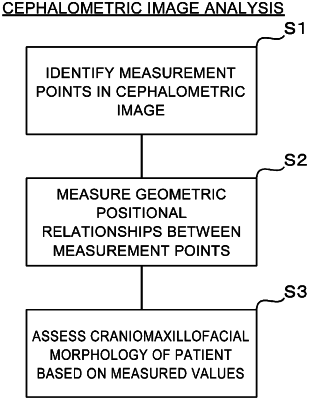| CPC A61B 6/501 (2013.01) [A61C 7/002 (2013.01); G06N 20/00 (2019.01); G06T 7/74 (2017.01); G06V 10/751 (2022.01); G06V 10/764 (2022.01); G06V 10/82 (2022.01); G06T 2207/10116 (2013.01); G06T 2207/20076 (2013.01); G06T 2207/20081 (2013.01); G06T 2207/20084 (2013.01); G06T 2207/30036 (2013.01)] | 12 Claims |

|
1. An automatic measurement point recognition method wherein a measurement point in a cephalometric image is automatically recognized with an arithmetic processor, the method comprising:
a step of detecting, from a cephalometric image acquired from a subject, a plurality of peripheral partial regions different from one another that have been predetermined with respect to a feature point of interest,
a step of estimating a candidate position of the feature point in each of the peripheral partial regions using a deep learning model trained to learn positions of the feature point in peripheral partial regions, and
a step of determining a most likely estimated position of the feature point in the cephalometric image based on the distribution of the candidate positions estimated, and determining that the most likely estimated position is the position of the measurement point,
wherein when the distribution density of the candidate positions shows at least two or more peaks and when any two candidate positions estimated as most likely positions from the tops of the respective peaks are distant from each other by a predetermined threshold value or a greater distance and,
the step of determining the position of the feature point comprises a processing that determines that the two candidate positions are separate measurement points with respect to the feature point.
|